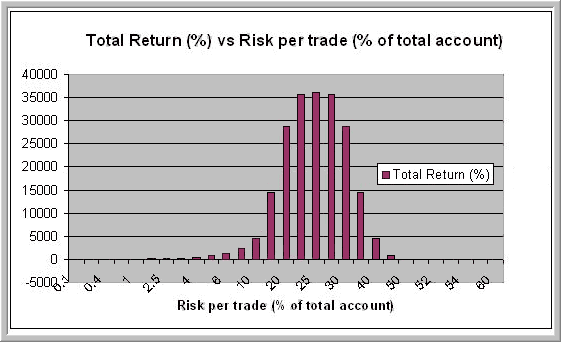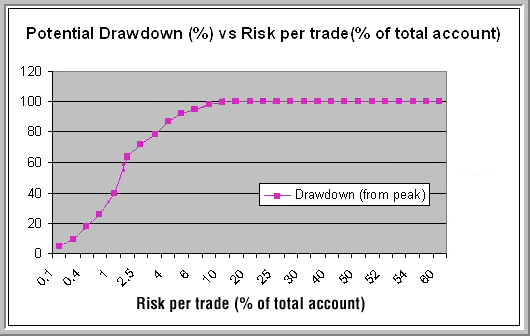
HOT TOPICS LIST
- Strategies
- Stocks
- Buy
- Investing
- Brokers
- Psychology
- Interviews
- Accumulate
- Sell
- Hold
- Spotlight
- Websites
- Candlestick Corner
- Gold & Metals
- Options Trading
LIST OF TOPICS
MONEY MANAGEMENT
Drawdown
09/27/06 03:11:12 PM PSTby Avinash Agrawal
Whether you invest on your own or through a money manager, keep in mind optimal trade-sizing techniques and apply them to an investing discipline instead of relying on your emotions.
| The essence of money management is about deciding how much of your account equity to risk on any given trade. Here's a look at the relationship between the long-term result of a series of trades and the amount of risk taken on a per-trade basis. The decision you make determines the risk of the trade. Accepting too much risk means that the penalty of being wrong is greater; too little risk and you will be rewarded little. Good money management is about finding the sweet spot between these two extremes. Considerations about trade sizing also help you fine-tune your money management skills for optimal results. FLIPPING COINS Consider a coin-flipping game with a positive expectancy. We will flip a coin in the air 100 times. You have $100 to bet. Every time the coin lands heads-up, you win $2. Every time the coin lands tails-up, you lose $1. How much should you bet on each flip of the coin, assuming that heads will land up 50% of the time, and tails will land up 50% of the time? Would you bet :
This is a mathematically positive expectancy game since you will have 50 heads and 50 tails, and the profit of $2 when you win is more than your loss of $1 when you lose. From Figure 1, you can see that starting with $100, if you bet:
So in this coin-flipping example, the optimal amount to risk is 25% of the total account equity on each bet. Note that such optimal amount to risk applies to the game only. It is intended to show that every investor should consider proper trade-sizing approaches to their investing discipline. |
| If you risk too little on each trade (that is, undertrade, as shown by the leftmost side of the graph in Figure 1), the returns will be too low. Risk more and the returns will increase, but the potential drawdown (account losses you will need to endure to get the return) always increases as you increase the per-trade risk (drawdowns are shown in Figure 2). Returns continue to increase moving into the overtrading zone as you move to the right on the graph in Figure 1, till the point at which 25% of the account is risked on any one trade, and returns decrease thereafter. As the graph in Figure 2 shows, the potential drawdowns increase as you increase the amount risked on any given trade. |
 FIGURE 1: HOW MUCH WOULD YOU MAKE? Here you see your risk vs. reward if you were to start with $100. If you risk 25% of your total account on each bet, you would end up with about $36,100.
|
| Trading at the peak of the potential return curve can be difficult psychologically because the per-trade drawdowns can be extremely high, and the margin of safety for dealing with unexpectedly high losing trades is very low. You are getting into territory where one huge loser can blow you out. The best place to live on this curve is the spot where you can deal with the emotional aspect of equity drawdown required to get the maximum return. Thus, most good traders do not risk more than 1-2% of their total account equity on any given trade. And they have the proper discipline to apply their investing methodology at all times. Whether you invest on your own or through a stock broker or money manager, keep in mind the importance of optimal trade-sizing techniques and apply them to a well-planned investing discipline, instead of relying on opinions, feelings, or emotions. |
| Avinash Agrawal holds master's degrees in electrical engineering and management science from Stanford University, where he majored in finance with an emphasis on pricing stocks and derivatives. |
| Website: | www.SierraInvestor.com |
PRINT THIS ARTICLE

|

Request Information From Our Sponsors
- StockCharts.com, Inc.
- Candle Patterns
- Candlestick Charting Explained
- Intermarket Technical Analysis
- John Murphy on Chart Analysis
- John Murphy's Chart Pattern Recognition
- John Murphy's Market Message
- MurphyExplainsMarketAnalysis-Intermarket Analysis
- MurphyExplainsMarketAnalysis-Visual Analysis
- StockCharts.com
- Technical Analysis of the Financial Markets
- The Visual Investor
- VectorVest, Inc.
- Executive Premier Workshop
- One-Day Options Course
- OptionsPro
- Retirement Income Workshop
- Sure-Fire Trading Systems (VectorVest, Inc.)
- Trading as a Business Workshop
- VectorVest 7 EOD
- VectorVest 7 RealTime/IntraDay
- VectorVest AutoTester
- VectorVest Educational Services
- VectorVest OnLine
- VectorVest Options Analyzer
- VectorVest ProGraphics v6.0
- VectorVest ProTrader 7
- VectorVest RealTime Derby Tool
- VectorVest Simulator
- VectorVest Variator
- VectorVest Watchdog

